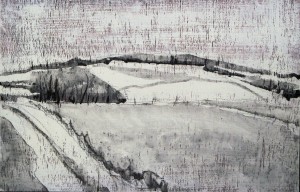John Valadez is new to me. His concerns are the dissipation and the distractions of contemporary (Southern CA) culture. His skill is brilliant. This piece, entitled “Pool Party,” was one of his strongest for what I read as a sober warning. The piece is arresting, or it should be I would think, if you still allow yourself compassion and an honest alertness for the dangers (metaphorical and real) we live in, for the people caught clueless when hell breaks loose. Look at these young girls, enjoying their candy colored lives, oblivious to the inferno about to overrun them. A writer I came across recently said that the time we are in now is like being sheltered in a basement during a tornado, where we are all screaming but the noise outside is so loud that no one hears even his own wide open scream. Valadez takes a calmer view. He has his characters playing through shallowness, while he clues the viewer that there is much more going on. This is maybe the California version of Munch’s “The Scream,” that ensign from another anxious era.
The local University art department where I live is sponsoring an exhibit this month called “The Day on Fire.” I guess they want to join the fun with all the 2012 apocalyptic talk going on. In fact, interest in the foreboding is happening everywhere. Prominent Galleries in NYC and London have had shows recently titled “Abstraction of Destruction,” and “Those Who Remain.” The jurors for our local fire show were shocked at how many entries they got from artists all over the nation wanting in on this subject. My entry, “Appointed” did not get into the final show. So goes it. I wonder if John Valadez’s piece would have made it in. My guess is no. He too takes this subject too seriously.
Emily Dickinson is another who took such things seriously. Here she is in her poem simply numbered #530:
You cannot put a Fire out —
A Thing that can ignite
Can go itself, without a Fan —
Upon the slowest Night –
You cannot fold a Flood –
And put it in a Drawer –
Because the Winds would find it out –
And tell your Cedar Floor –
 I don’t think it is a very pretty piece, and therefore, to me, it is all the more true.
I don’t think it is a very pretty piece, and therefore, to me, it is all the more true. Like so many for me, this piece is marked out not with any message intended, but rather as a physical response to all that rumbles within. And there is a lot rumbling within. It surprised me when it got done. I started it last summer and fine-tuned it just last month. There is one collaged phrase that is embedded in other text-like markings: “pray for Jerusalem’s peace.” Again, I emphasize, this piece was not a pretext to say that, but rather a natural and right seeming way to finish what I was looking at. There is a lot of energy in this piece, layering, piercing and shroudedness. I showed it to a friend who is very bright but very un-artsy and he said before seeing the text fragment “it looks like a swastika.” Ridiculous! I went home and did some research on that symbol and then became even more interested in that strange possibility, especially that in my case the symbol is definitely broken up at its core. I say all this to try to help the reader understand some of what happens in art making: it is a duet, it is intention made visual, it is something that goes beyond the artist. It can be deadly or it can be good, and often is maybe even both. Such it is for things that come from our hands and our hearts. Such it is when even these things can go beyond our hands and our hearts.
Like so many for me, this piece is marked out not with any message intended, but rather as a physical response to all that rumbles within. And there is a lot rumbling within. It surprised me when it got done. I started it last summer and fine-tuned it just last month. There is one collaged phrase that is embedded in other text-like markings: “pray for Jerusalem’s peace.” Again, I emphasize, this piece was not a pretext to say that, but rather a natural and right seeming way to finish what I was looking at. There is a lot of energy in this piece, layering, piercing and shroudedness. I showed it to a friend who is very bright but very un-artsy and he said before seeing the text fragment “it looks like a swastika.” Ridiculous! I went home and did some research on that symbol and then became even more interested in that strange possibility, especially that in my case the symbol is definitely broken up at its core. I say all this to try to help the reader understand some of what happens in art making: it is a duet, it is intention made visual, it is something that goes beyond the artist. It can be deadly or it can be good, and often is maybe even both. Such it is for things that come from our hands and our hearts. Such it is when even these things can go beyond our hands and our hearts.